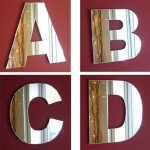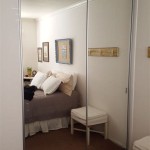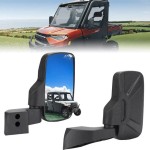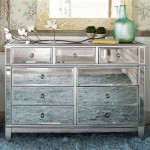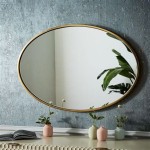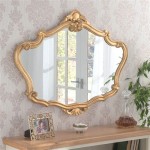What Should I Use To Hang A Large Mirror?
Hanging a large, heavy mirror requires careful consideration to ensure both safety and stability. Choosing the appropriate hanging hardware depends on several factors, including the mirror's weight, the wall material, and the desired aesthetic. This article will explore various options available for securely mounting large mirrors.
Heavy-Duty D-Rings and Wire
D-rings are metal rings shaped like a "D" attached to the back of the mirror. When paired with heavy-gauge wire, they provide a robust hanging solution for heavier mirrors. The wire is strung between the D-rings and looped over hooks or screws installed in the wall. This method distributes the weight evenly, reducing stress on any single point.
French Cleats
French cleats offer a strong and secure hanging mechanism, particularly suitable for very large and heavy mirrors. They consist of two interlocking pieces of wood or metal, one attached to the wall and the other to the back of the mirror. The angled design creates a tight grip when the mirror section is slid down onto the wall section. This method provides excellent weight distribution and prevents tilting.
Mirror Mounting Clips
Mirror mounting clips, sometimes called J-clips or Z-clips, are another popular choice for securing large mirrors. These clips grip the edges of the mirror and are then fastened to the wall. They offer a sleek, minimalist look as most of the hardware remains hidden. Different styles of clips are available, accommodating various mirror thicknesses and weights. Choosing the correct size and weight capacity is essential for safe installation.
Adhesive Hooks and Strips
While heavy-duty adhesive hooks and strips can hold surprising weight, they are generally not recommended for large, heavy mirrors. These products rely on a strong adhesive to bond to the wall and the mirror backing. Over time, temperature fluctuations, humidity, and the sheer weight of the mirror can weaken the adhesive bond, potentially leading to the mirror falling. For smaller, lighter mirrors, adhesive solutions can be a convenient option, but for large, heavy mirrors, mechanical fastening methods are always preferable.
Wall Anchors and Screws
Regardless of the chosen hanging method, appropriate wall anchors and screws are crucial for securing the mirror to the wall. The type of anchor required depends on the wall material. Drywall requires specific anchors, like toggle bolts or molly bolts, to provide a secure hold in the hollow space behind the wall surface. For solid walls made of brick or concrete, masonry anchors are necessary.
Choosing the Right Hardware for Your Wall
Different wall materials require different types of fasteners. Understanding the composition of your wall is essential for selecting the correct anchors and screws. Failure to use appropriate hardware can result in the mirror falling, causing damage and potential injury. Consult a hardware professional for recommendations if you are unsure about the appropriate fasteners for your wall type.
Weight Considerations
The weight of the mirror is a primary factor in determining the appropriate hanging method. Lighter mirrors might be suitable for D-rings and wire or even adhesive solutions. However, heavier mirrors require more robust solutions like French cleats or heavy-duty mirror clips. Always check the weight capacity of the chosen hardware to ensure it exceeds the weight of the mirror. Overloading hanging hardware is a significant safety hazard.
Professional Installation
For exceptionally large or heavy mirrors, professional installation is highly recommended. Professional installers have the experience and expertise to assess the wall structure, select the appropriate hardware, and ensure the mirror is securely and safely mounted. They also possess the necessary tools and equipment to handle large and delicate items, minimizing the risk of damage during installation.
Preparing the Wall Surface
Before installing any hanging hardware, prepare the wall surface. Ensure the area is clean and free of dust and debris. Fill any holes or imperfections with spackle and allow it to dry completely. A smooth, clean surface will provide the best adhesion for anchors or other hardware and ensure a flush, stable mount for the mirror.
Measuring and Marking
Accurate measurements and markings are critical for a successful installation. Measure the mirror dimensions and carefully mark the desired location on the wall. Use a level to ensure the markings are straight and even. Precise measurements will prevent crooked hanging and ensure the mirror sits flush against the wall.
Safety Precautions
When hanging a large mirror, prioritize safety. Wear appropriate safety gear, including gloves and eye protection. Enlist the help of another person when lifting and positioning heavy mirrors. Never attempt to hang a mirror that exceeds your physical capabilities. Taking necessary safety precautions will minimize the risk of accidents and injuries during the installation process.

How To Hang A Large Or Heavy Mirror

How To Hang A Large Wall Mirror Step By Tutorial

How To Hang A Heavy Mirror C R F T
How To Hang A 100 Pound Mirror On Drywall Quora

How To Hang A Heavy Mirror

How To Hang A Large Wall Mirror Step By Tutorial

How To Hang A Heavy Mirror Lowe S

How To Hang A Heavy Mirror

How To Hang A Mirror Perfectly

How To Hang A Heavy Mirror With Pictures Wikihow

